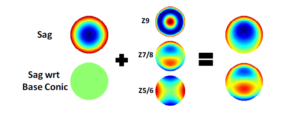Kyle Fuerschbach, Jannick P. Rolland, and Kevin P. Thompson
Unobscured optical systems have been in production since the 1960s. In each case, the unobscured system is an intrinsically rotationally symmetric optical system with an offset aperture stop, a biased input field, or both. This paper presents a new family of truly nonsymmetric optical systems that exploit a new fabrication degree of freedom enabled by the introduction of slow-servos to diamond machining; surfaces whose departure from a sphere varies both radially and azimuthally in the aperture. The benefit of this surface representation is demonstrated by designing a compact, long wave infrared (LWIR) reflective imager using nodal aberration theory. The resulting optical system operates at F/1.9 with a thirty millimeter pupil and a ten degree diagonal full field of view representing an order of magnitude increase in both speed and field area coverage when compared to the same design form with only conic mirror surfaces.



